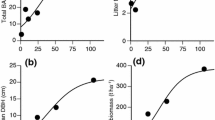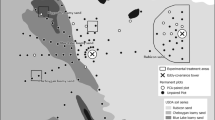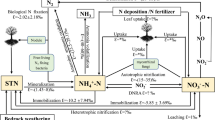Abstract
Understanding the changes in the plant community and soil nitrogen (N) availability during natural recovery of a forest following clear-cutting is critical to develop post-disturbance forest management strategies. Therefore, post-clearcut changes in vegetation, net N mineralization rates and available N concentrations in soil were studied in a montane subtropical broadleaved forest during the early years of recovery following a chronosequence approach. Two replicate stands were selected for each treatment of old-growth undisturbed forest and recovering forest stands aged 1, 5 and 10 years. Following disturbance, tree species diversity and basal area declined but shrub and herb diversity increased. High percentage dissimilarity among the stands in tree, shrub and herb species composition indicated that species colonization varied with recovery age. NH4 +-N and NO3 −-N concentrations increased significantly (P < 0.001) following clear-cutting and the increasing trend continued until 5 years post-recovery, after which it declined. While ammonification rate remained unchanged with recovery age, nitrification and net N mineralization rates in 10-year-old and undisturbed forest were significantly greater (P < 0.001) than in 1- and 5-year-old forest, indicating that mineralization rates increased with recovery age. Despite high mineralization rates, low availability of soil N in the later years of recovery was attributed to high N uptake by growing vegetation and leaching because of high rainfall in Cherrapunjee. To ensure N availability during the later years of recovery, we suggest that forest management intervention should encourage aided regeneration of native N-fixing trees, e.g., Myrica esculenta, during the initial years of recovery.








Similar content being viewed by others
References
Aber JD, Nadelhoffer KJ, Steudler P, Melillo JM (1989) Nitrogen saturation in northern forest ecosystems. Bioscience 39:378–386
Addo-Fordjour P, Obeng S, Anning AK, Addo MG (2009) Floristic composition, structure and natural regeneration in a moist semi-deciduous forest following anthropogenic disturbances and plant invasion. Int J Biodivers Conserv 1:21–37
Allen SE, Grimshaw HM, Parkinson JA, Quarmby C (1974) Chemical analysis of ecological materials. Blackwell Scientific Publications, Oxford
Anderson JM, Ingram JSI (1993) Tropical soil biology and fertility: a handbook of methods, 2nd edn. C.A.B International, Wallingford
Arunachalam K, Arunachalam A (1999) Effect of temperature on N-mineralization in soils of humid subtropical regrowth in Meghalaya, India. Ind J Soil Cons 27:50–54
Balakrishnan NP (1981–1983) Flora of Jowai and vicinity, Meghalaya (Vols. 1 and 2). BSI, Howrah
Barg AK, Edmonds RL (1999) Influence of partial cutting on site microclimate, soil nitrogen dynamics, and microbial biomass in Douglas-fir stands in Western Washington. Can J For Res 29:705–713
Bauhus J, Puettmann KJ, Kühne C (2013) Close-to-nature forest management in Europe: does it support complexity and adaptability of forest ecosystems? In: Messier C, Puettmann KJ, Coates KD (eds) Managing forests as complex adaptive systems: building resilience to the challenge of global change. The Earthscan forest library, Routledge, pp 187–213
Begon M, Harper JL, Townsend CR (1990) Ecology: individual, populations and communities. Blackwell Science, Massachussets
Belbin L, McDonald C (1993) Comparing three classification strategies for use in ecology. J Veg Sci 4:341–348
Belleau A, Brais S, Pare´ D (2006) Soil nutrient dynamics after harvesting and slash treatments in boreal aspen stands. Soil Sci Soc Am J 70:1189–1199
Belote R, Sanders NJ, Jones RH (2009) Disturbance alters local regional richness relationships in Appalachian forests. Ecology 90:2940–2947
Berkowitz AR, Canham CD, Kelly VR (1995) Competition vs. facilitation of tree seedling growth and survival in early successional communities. Ecology 76:1156–1168
Booth MS, Stark JM, Rastetter E (2005) Controls on nitrogen cycling in terrestrial ecosystems: a synthetic analysis of literature data. Ecol Monogr 75:139–157
Cadenasso ML, Traynor MM, Pickett STA (1997) Functional location of forest edges: gradients of multiple physical factors. Can J For Res 27:774–782
Cao Y, Bark AW, Williams WP (1997) A comparison of clustering methods for river benthic community analysis. Hydrobiologia 347:25–40
Champion HG, Seth SK (1968) A revised survey of forest types of India. Government of India Press, Delhi, pp 251–267
Chapman SK, Langley JA, Hart SC, Koch GW (2006) Plants actively control nitrogen cycling: uncorking the microbial bottleneck. New Phytol 169:27–34
Chettri A, Barik SK, Pandey HN, Lyngdoh MK (2010) Liana diversity and abundance as related to microenvironment in three forest types located in different elevational ranges of the Eastern Himalayas. Pl Ecol Div 3:175–185
Crawley MJ (1986) Plant Ecology. Blackwell Scientific Publications, Oxford
Dahlgren RA, Driscoll CT (1994) The effects of whole-tree clear-cutting on soil processes at the Hubbard Brook Experimental Forest, New Hampshire, USA. Plant Soil 158:239–262
Dufrêne M, Legendre P (1997) Species assemblages and indicator species: the need for a flexible asymmetrical approach. Ecol Monogr 67:345–366
Elliott KJ, Boring LR, Swank WT (2002) Aboveground biomass and nutrient accumulation 20 years after clear-cutting a southern Appalachian watershed. Can J For Res 32:667–683
Eno CF (1960) Nitrate production in the field by incubating the soil in buried polyethylene bags. Soil Sc Soc Am Proc 24:277–279
Feng G, Kai Z, Yun-Qi Z, Qin W, Xiao-Niu X (2011) Nitrogen in soils beneath 18–65 year old stands of subtropical evergreen broad-leaved forests in Laoshan Mountains in Eastern China. J For Res 22:583–590
Finer L, Mannerkoski H, Piirainen S, Starr M (2003) Carbon and nitrogen pools in an old-growth, Norway spruce mixed forest in eastern Finland and changes associated with clear-cutting. For Ecol Manage 174:51–63
Grant RF, Barr AG, Black TA, Margolis HA, Mccaughey JH, Trofymow JA (2010) Net ecosystem productivity of temperate and boreal forests after clearcutting—a Fluxnet-Canada measurement and modelling synthesis. Tellus 62B:475–496
Guntiñas ME, Leirós MC, Trasar-Cepeda C, Gil-Sotres F (2012) Effects of moisture and temperature on net soil nitrogen mineralization: a laboratory study. Eur J Soil Biol 48:73–80
Gutiérrez Beltrán N, Gärtner S, Gaviriar JC, Meier W, Reif A (2012) Successional vegetation patterns in abandoned pastures of the lower montane cloud forest zone in the Venezuelan Andes. Phytocoenologia 42:101–132
Hammer Ø, Harper DAT, Ryan PD (2001) PAST: paleontological statistics software package for education and data analysis. Palaeontologia Electronica 4:9
Haridasan K, Rao RR (1985–1987) Forest flora of Meghalaya (Vols. 1 and 2). Bishen Singh Mahendrapal Singh, Dehradun, India
Hubbell SP (1979) Tree dispersion, abundance and diversity in a tropical dry forest. Science 203:1299–1309
Hynes HM, Germida JJ (2013) Impact of clear-cutting on soil microbial communities and bioavailable nutrients in the LFH and Ae horizons of Boreal Plain forest soils. For Ecol Manage 306:88–95
Jerabkova L, Prescott CE, Titus BD, Hope GD, Walters MB (2011) A meta-analysis of the effects of clearcut and variable-retention harvesting on soil nitrogen fluxes in boreal and temperate forests. Can J For Res 41:1852–1870
Kamei J, Pandey HN, Barik SK (2009) Tree species distribution and its impact on soil properties, and nitrogen and phosphorus mineralization in a humid subtropical forest ecosystem of northeastern India. Can J For Res 39:36–47
Kent M (2012) Vegetation description and data analysis: a practical approach, 2nd edn. Wiley-Blackwell, Oxford
Kern CC, Palik BJ, Strong TF (2006) Ground-layer plant community responses to even-age and uneven-age silvicultural treatments in Wisconsin northern hardwood forests. For Ecol Manage 230:162–170
Kimmins JP (2004) Forest ecology: a foundation for sustainable forest management and environmental ethics in forestry, 3rd edn. Pearson Prentice Hall, NJ
Knoepp JD, Swank WT (1997) Forest management effects on surface soil carbon and nitrogen. Soil Sci Soc Am J 61:928–935
Lalfakawma, Sahoo UK, Roy S, Vanlalhriatpuia K, Vanalalhluna PC (2009) Community composition and tree population structure in undisturbed and disturbed tropical semi–evergreen forest stands of North–east India. Appl Ecol Environ Res 7:303–318
Li X, Wilson SD, Song Y (1999) Secondary succession in two subtropical forests. Plant Ecol 143:13–21
Li GC, Han XG, Huang JH (2004) N mineralization and nitrification in a primary Lithocarpus xylocarpus forest and degraded vegetation in the Ailao Mountain, Yunnan Province. Acta Bot Sin 46:194–201
Lovell RD, Jarvis SC, Bardgett RD (1995) Soil microbial biomass and acidity in long-term grassland: effects of management changes. Soil Biol Biochem 27:969–975
Magnusson WE, Lima OP, Reis FQ, Higuchi N, Ramos JF (1999) Logging activity and tree regeneration in an Amazonian forest. For Ecol Manage 113:67–74
Magurran AE, McGill BJ (2011) Biological diversity: frontiers in measurement and assessment. University Press, Oxford
Maithani K, Arunachalam A, Tripathi RS, Pandey HN (1998) Nitrogen mineralization as influenced by climate, soil and vegetation in a subtropical humid forest in northeast India. For Ecol Manage 109:91–101
Miki T, Kondoh M (2002) Feedbacks between nutrient cycling and vegetation predict plant species coexistence and invasion. Ecol Lett 5:624–633
Misra R (1968) Ecology work book. Oxford and IBH Publication Co., New Delhi
Moss D, Wright JF, Furse MT, Clarke RT (1999) A comparison of alternative techniques for prediction of the fauna of running-water sites in Great Britain. Freshwater Biol 41:167–181
Noble IR, Slatyer RO (1980) The use of vital attributes to predict successional changes in plant communities subject to recurrent disturbances. Vegetatio 43:5–21
O’Connell AM, Grove TS, Mendham DS, Rance SJ (2004) Impact of harvest residue management on soil nitrogen dynamics in Eucalyptus globulus plantations in south western Australia. Soil Biol Biochem 36:39–48
Okuda T, Adachi N, Suzuki M, Quah ES, Manokaran N (2003) Effect of selective logging on canopy and stand structure in a lowland dipterocarp forest in Peninsular Malaysia. Forest Ecol Manage 175:297–320
Owen JS, Wang MK, Wang CH, King HB, Sun HL (2003) Net N mineralization and nitrification rates in a forested ecosystem in northeastern Taiwan. For Ecol Manage 176:519–530
Paavolainen L, Smolander A (1998) Nitrification and denitrification in soil from a clear-cut Norway spruce (Picea abies) stand. Soil Biol Biochem 30:775–781
Peltzer DP, Bast ML, Wilson SD, Gerry AK (2000) Plant diversity and tree responses following contrasting disturbances in boreal forest. For Ecol Manage 127:191–203
Peterson CJ, Squiers ER (1995) Competition and succession in an aspen-white-pine forest. J Ecol 83:449–457
Piatek KB, Allen HL (1999) Nitrogen mineralization in a pine plantation fifteen years after harvesting and site preparation. Soil Sci Soc Am J 63:990–998
Prest D, Kellman L, Lavigne MB (2014) Mineral soil carbon and nitrogen still low three decades following clear-cut harvesting in a typical Acadian Forest stand. Geoderma 214–215:62–69
Radler K, Oltchev A, Panferov O, Klinck U, Gravenhorst G (2010) Radiation and temperature responses to a small clear-cut in a spruce forest. The Open Geogr J 3:103–114
Ramakrishnan PS, Ram SC (1988) Vegetation, biomass and productivity of seral grasslands of Cherrapunji in north-east India. Vegetatio 74:47–53
Rao P, Barik SK, Pandey HN, Tripathi RS (1990) Community composition and tree population structure in a sub-tropical broad-leaved forest along a disturbance gradient. Vegetatio 88:151–162
Redding TE, Hope GD, Fortin M-J, Schmidt MG, Bailey WG (2002) Spatial patterns of soil temperature and moisture across subalpine forest-clearcut edges in the southern interior of British Columbia. Can J Soil Sci 83:121–130
Rees DC, Juday GP (2002) Plant species diversity on logged versus burned sites in central Alaska. For Ecol Manage 155:291–302
Reynolds PE, Thevathasan NV, Simpson J, Gordon A, Lautenschlager AM, Bell RA, Gresch WF, Buckley DA (2000) Alternative forest release treatments affect microclimate and soil nitrogen mineralization. For Ecol Manage 133:115–125
Rolecek J, Tichy L, Zeleny D, Chytry M (2009) Modified TWINSPAN classification in which the hierarchy respects cluster heterogeneity. J Veg Sci 20:596–602
Schulze E-D, Beck E, Mueller-Hohenstein K (2005) Plant Ecology. Springer-Verlag, Berlin
Sørensen J (1948) A method of establishing groups of equal amplitude in plant sociology based on similarity of species content. Detkong. Dauske Vidrnsk. Selsk Biol Skn 5:1–34
Templer P, Findlay S, Lovett G (2003) Soil microbial biomass and nitrogen transformations among five tree species of the Catskill Mountains, New York, USA. Soil Biol Biochem 35:607–613
Upadhaya K, Pandey HN, Law PS, Tripathi RS (2005) Dynamics of fine and coarse roots and nitrogen mineralization in a humid subtropical forest ecosystem of northeast India. Biol Fertil Soils 41:144–152
Van Miegroet H, Homann PS, Cole DW (1992) Soil nitrogen dynamics following harvesting and conversion of red alder and Douglas-fir stands. Soil Sci Soc Am J 56:1311–1318
Wall A, Hytönen J (2011) The long-term effects of logging residue removal on forest floor nutrient capital, foliar chemistry and growth of a Norway spruce stand. Biomass Bioenergy 35:3328–3334
Wang F, Zhu W, Xia H, Fu S, Li Z (2010) Nitrogen mineralization and leaching in the early stages of a subtropical reforestation in Southern China. Restor Ecol 18:313–322
Westhoff V, van der Maarel E (1978) The Braun-Blanquet approach. In: Whittaker RH (ed) Classification of plant communities. Dr. W Junk, The Hague, pp 287–399
Yan ER, Wang X, Huang J (2008) Decline of soil nitrogen mineralization and nitrification during forest conversion of evergreen broad-leaved forest to plantations in the subtropical area of Eastern China. Biogeochemistry 89:239–251
Zenner EK, Kabrick JM, Jensen RG, Peck JE, Grabner JK (2006) Responses of ground flora to a gradient of harvest intensity in the Missouri Ozarks. For Ecol Manage 222:326–334
Acknowledgments
The first author is grateful to the Council for Scientific and Industrial Research, Govt. of India for providing financial assistance in the form of NET-Junior Research Fellowship (File No: 09/347(0175)/2005-EMR-I). The facilities created under the Centre for Advanced Studies (CAS) in Botany program were utilized for this research, for which the authors express their gratitude to the Coordinator of CAS, Department of Botany, and Head, Department of Botany, NEHU, Shillong. Thanks are also due to the Headmen of Sohrarim and Laitryngew villages who gave permission to carry out the research work in the forest stands under their jurisdiction. The authors are grateful for the valuable comments on the earlier versions of the ms. from the handling Editor of Ecological Research, Prof. Albert Reif and the anonymous reviewer who helped to improve the manuscript.
Author information
Authors and Affiliations
Corresponding author
Appendix
Appendix
See Table 7.
About this article
Cite this article
Mylliemngap, W., Nath, D. & Barik, S.K. Changes in vegetation and nitrogen mineralization during recovery of a montane subtropical broadleaved forest in North-eastern India following anthropogenic disturbance. Ecol Res 31, 21–38 (2016). https://doi.org/10.1007/s11284-015-1309-8
Received:
Accepted:
Published:
Issue Date:
DOI: https://doi.org/10.1007/s11284-015-1309-8




